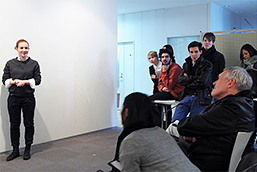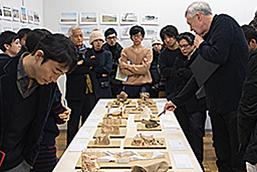DEPARTMENT OF ARCHITECTURE
Department/course summary
From 1886 through 1887, Japan’s Ministry of Education assigned three individuals―Ernest Francisco Fenollosa, Arata Hamao, and Tenshin Okakura―to undertake a survey of Western arts education as preparation to found a school of art. Architecture in the economically vital United States was at the crest of the Greek Revival movement, with strong influences from the Ecole des Beaux Arts of France. Observing these conditions in architecture and education, Fenollosa and Okakura chose to include a department of architecture within their plans for a school of fine arts.
An architecture studio was eventually established within the design department in 1902, marking the beginnings of full-fledged architectural education within what would become the Architecture Department in 1923. From the establishment of this architecture studio to the present day, the department and its predecessors have produced leading figures in Japanese architecture.
Unique characteristics of the Architecture Department
A unique characteristic of the Department of Architecture is that Tokyo University of the Arts remains, since its founding, the only national educational institution in Japan whose primary purpose is to train architects within a faculty focused on the fine arts.
Also, instruction takes place in small groups (enrollment is limited to 15 undergraduate students and 18 master’s degree students). The goal of this structure is to provide guidance and education based on in-depth interactions between instructors and individual students.
>>??Official Website
Policy
Curriculum Policy
Faculty: The unique characteristic of the educational philosophy of the Architecture Department is the emphasis on the acquisition of “architectural design skills.” The department has organized an educational system that enables students to pursue originality of expression and sharpen their sensibilities while fostering a wide range of scientific knowledge and thinking ability.
The aim is to nurture individuals with a strong passion for architecture on a one-to-one basis via training based on practical techniques.
The curriculum comprises specialized areas of practical technique (architectural design) and specialized subjects of study in the department. The specialized areas of practical technique advance in a phased manner based on the design challenges in each academic year. Furthermore, the curriculum conforms to the architecture-related subjects designated with regard to the examination of becoming kenchikushi or certified architects.
Master: The Master’s Program curriculum consists of lectures and courses in practical technique. With acquired undergraduate educational content as the basis, the lectures focus on the study of more advanced and specialized content (architectural history, environmental planning, architectural structure theory, architectural urban planning theories, and theory of architecture). Courses in practical technique include seminars conducted in studio divisions and involve identifying and implementing a research theme under the guidance of the faculty. Furthermore, it is also possible to obtain credits pertaining to practical experience in graduate school for the kenchikushi (architecture) examination.
Doctor: Individuals who have obtained the Master’s degree can further expand their knowledge in their specialized research. In the doctoral program, students develop the knowledge about their own research themes as they work toward obtaining their doctoral degrees based on work done at the research laboratory to which they belong and present the results outside the university.
Diploma Polycy
Faculty: The Bachelor’s degree is awarded once the abovementioned curriculum policy has been fulfilled and the final year of graduation work has been thoroughly assessed.
Master: The Master’s degree is awarded once the abovementioned curriculum policy is fulfilled and the Thesis Review Committee comprising the supervisor in the concerned research field and the faculty in related fields have thoroughly assessed the creative work and thesis at the master’s level.
Doctor: The doctoral degree is awarded once the abovementioned curriculum policy is fulfilled and the Thesis Review Committee comprising the supervisor in the concerned research field and the faculty in related fields have thoroughly assessed the creative work and dissertation at the doctoral level.
Curriculum
Curriculum (undergraduate education)
 *Summary
*Summary
While educational content does not depart dramatically from that of departments of architecture at other universities in Japan attached to engineering faculties, the Architecture Department’s educational philosophy places a special emphasis on imparting architectural design skills. Courses of instruction are designed to broaden academic knowledge and cultivate deep, patient reasoning capabilities on the one hand, and to encourage the development of aesthetic acuity and an independent vision on the other. The goal is to develop individuals passionately engaged with architecture through training based on guidance in practical techniques on a one-on-one basis.
The curriculum is divided into specific areas of practical technique (architectural design) and specific topics of study.
First year: Various creative topics are addressed in an introduction to architectural design, including basic training in areas such as structural norms of architecture and related modes of expression. As an example, the design and building of chairs using wood is a traditional department subject, studied for over 40 years.
Second year: The first semester focuses on residential structures; the second semester addresses institutions of learning. Students proceed from a study of personal spaces to spaces designed for group activities. At the end of their second year, students study structural design as a foundation for realizing spaces and forms.
Third year: Based on the theme of spatial organization in architecture, topics of study shift toward meeting places and more complex structures. In addition, students look at the social nature of architecture from a broad perspective to identify the various ways in which architecture creates links and relations in the world. Selected instructors invited from outside the program add to this course of study. Travel to study ancient art, scheduled for the fall, offers an opportunity to look anew at traditional examples of Japanese architecture and the spatial structures they embody, prompting consideration of possible links to modern architectural expression.
Fourth year: At the start of this year, based on experiences from the first three years of the program, students turn toward senior projects while learning how to identify ideal forms for large-scale urban spaces – spaces on the scale of city blocks and beyond; how to plan a design development program; and how to choose among various approaches to presenting their proposals, among other topics. Students are then given preliminary assignments that serve as the starting points for thesis projects. They begin working on their thesis projects during the summer session, independently handling all aspects of their thesis projects, including establishing themes, conditions, and programs, refining their own ideas into feasible projects and devoting intensive work over an extended period of time.
Curriculum (graduate education and research)
The curriculum for the master’s degree program in the graduate school is also divided into two main categories. The first consists of academic topics (specific architectural subjects such as architectural history, structure, architectural planning, and architectural theory) at more advanced and specialized levels, based on knowledge accrued as undergraduates. The second involves identifying and implementing a research theme based on the student’s interests under guidance from instructors in seminars held at the studio to which the student belongs. The graduation project and graduation dissertation represent a distillation of these efforts.
In doctoral programs, students deepen their understanding of selected research themes as they work toward their doctoral degrees, presenting their results outside the department at periodic intervals, all based on work done within the studios to which the students belong.
Other information
The Department is active in foreign exchange efforts, chiefly with schools that have signed international exchange agreements with the university.
Following graduation, most students are employed in architectural offices or in construction-related design departments. Listed below are some major employers of graduates over recent years.
*Admissions policies (undergraduate)
The Department of Architecture has trained and graduated large numbers of Japan’s leading architects.
We admits prospective students who seek to master architectural design by acquiring the knowledge, understanding, and skills required to realize the functionality, strength, and beauty architectural design demands.
*Admissions policies (graduate)
The Department of Architecture seeks to train more specialized architects and researchers, based on the knowledge and techniques mastered during undergraduate years. While lectures including special seminars are attended by all those enrolled in the program, core creative and research activities occur in studios managed chiefly by individual instructors. Prospective students interested in this program are asked to identify the research and creative interests of each instructor and to compare these against their own interests before making appointments to meet with specific instructors.





